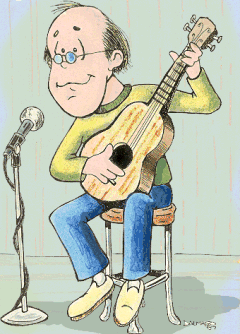|
Contents: |

Some of my earliest musical memories are of singing with my mom in the car on long trips; she loved to harmonize and she'd have me singing melody. She also played a baritone ukulele and would accompany my grandmother's mandolin playing. (Grandma played for dances as a teenager growing up in Sweden.)
At the age of nine, I took piano and organ lessons for a while and then moved on to actually playing Mom's ukulele—old songs from the '40s and '50s that I gleaned from her songbooks. The guitar came along at about the age of twelve. I guess I had a few gigs in my "early period," like playing for Christmas parties at school, performing old Smothers Brothers routines in the fourth grade and singing "A Boy Named Sue" at a square dance retreat.
At 15, I started studying classical guitar, and this really turned me on to fingerstyle guitar. But while I loved some of those Villa-Lobos Etudes and Preludes, and still do, I was more attuned to popular music, both instrumental and vocal, and I gravitated to the likes of Glenn Campbell, James Taylor, the Beatles, Chet Atkins, Jerry Reed and Pierre Bensusan (still my favs).
After pursuing an education in forestry and forest genetics in Maine and North Carolina for ten long years (don't ask), I awoke one morning and decided that I should dump all that and see if I couldn't make a living with the guitar. I had already discovered that I had a flair for teaching people how to dance—swing, waltz, Scandinavian and eastern European—so it wasn't too much of a leap to teaching guitar. So I opened the Bruce Emery Guitar Studio in 1986 and never looked back. Except that guitars and books come from trees. But that's it, I swear.
Noticing the lack of even a SINGLE readable guitar theory book on the market, I wrote the Skeptical Guitarist series between 1997 and 1999, and then I figured I was done writing method books. But I began receiving requests from beginning players for information that was more basic, like how to play the bloody thing. So I began writing the Guitar From Scratch series in 2001: Fingerstyle, Blues, Travis-Style and Christmas.
Then around 2010, as the Ukulele Scare showed no signs of abating, I started my Ukulele and Baritone Ukulele series: From Scratch, Blues and Christmas, and those books have pulled ahead of the guitar stuff and have stayed there. Some mandolin books and a bass book have rounded out the catalog, and the laminated chord charts are doing quite well, so there should be more of them on the horizon, along with some kind of James Taylor fingerstyle guitar project.
In 2006 and 2007, I produced three CDs with me on guitar and David McKnight on violin and mandolin: two of popular jazz, folk and blues instrumentals, called Windy & Warm and Night & Day, and one of traditional Christmas tunes, All Is Calm, All Is Bright. We had a fourth one in the can, but the market for CDs was shrinking, so we decided to cool our jets. I still have copies available for as little as $0.00 plus shipping. Merely a suggestion.
These days I am deeply involved in playing the resonator octave mandolin (a sort of bouzouki) in a 9-piece band called Scandimonium. You'll never guess what kind of music we play. The primary instrument used in the Swedish music tradition is the fiddle, and we have a few of 'em, a nyckelharpa (the Swedish national instrument), keyboard, percussion, cello, hammarharpa (hammered dulcimer, really) and me. Here's a link to our web site: http://scandimonium.padd.com/.
It's a major change for me. As a solo fingerstyle guitar player, I do fixed arrangements that have me playing melody, bass and chords, as in classical guitar. But in the band, with all those fiddles playing the melody, my role shifts to coming up with bass lines, harmony lines and chords, which are sort of improvised, in the style of Roger Tallroth, late of Väsen. You never play a part the same way twice. Infinite learning.
Rob Sharer, the Reso-Dude, built my instrument, and maybe he could be convinced to build one for you. Same as a mandolin, only bigger and tuned one octave lower. Rob built the thing and painted it blue and yellow, the colors of the Swedish flag, long before I even knew him! Another coincidence: He's my next-door neighbor. 'Twas meant to be.
As for my other Weapons of Musical Destruction, my guitars are a James Olson cutaway acoustic (another Swede), a George Lowden O-series acoustic (an Irishman) and a Kirk Sand nylon string electric (Californian). My mandolin is a Tacoma and my uke is a Kala. I am sure that the sales figures for these companies will surge, now that I, the Skeptical Guitarist, have revealed my favorites. They are welcome.